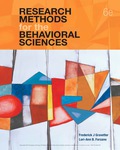
In addition to the key words, you should also be able to define the following terms:
Within-subjects design
Between-subjects design
Independent-measures design
Random assignment
Variance within treatments, or variance within groups
Differential attrition
Diffusion
Compensatory equalization
Compensatory rivalry
Resentful demoralization
Single-factor two-group design, or two-group design
Single-factor multiple-group design
To explain:
Explain the given terms.
Explanation of Solution
Solution:
Between subjects:
This is the case when for each unique combination of the independent factors there are different subjects assigned to them. There are different set of subjects in each cell.
Within subjects:
This is the case when the same set of subjects is experimented in two or more different unique combination of factors. Thus when the subjects are repeated in different levels of the factors, it generates a within subject design.
Example:
- Suppose a research is done about the effect of training on employees. There are two training modules. 10 employees are assigned to each module. Thus there are total 20 employees who participate in this research.
- These 20 employees are scored before the training and then randomly assigned to the two different training modules. After the training is the done, the same 20 employees re scored again.
- In this entire research, the score serves as the response variable. There are two independent variables involved: time and training. There are two levels of time: before and after and there are two levels of training: module A and module B.
- The subjects assigned to the factor time before and after are same. Thus it should be within-subjects
- The subjects assigned to the factor training: module A and module B, are different. Thus it should be between-subjects.
Independent measures design:
An independent measures design is a research method in which several trial groups are used and participants are only in one group. Each participant is only in one factor of the independent variable during the experiment.
Random assignment:
Random assignment is a technique for placing participants to different groups in an experiment using randomization. This can be done using flipping the coin or by using random numbers. This ensures every participant has an equal chance of being selected in any group and each group is equivalent.
Variance within treatments or variance within groups:
The variance due to the differences in scores within individual treatment group is called Variance within treatments or variance within groups.
Differential attrition:
Attrition is the loss of subjects/experimental units from a sample. It occurs when an analysis does not include a subjects/experimental units who were randomly assigned. For example, 50 experimental units were there in the sample but in follow-up study, only 40 experimental units were available. To calculate differential attrition, you need Attrition for the intervention group and Attrition for the comparison group. The differential attrition is the absolute difference between these two attritions.
Diffusion:
Sometimes the treatment and control group participants can speak with each other. The threat is that a few parts of the exploratory jolt are passed on from the treatment group to the control group; that is, there is a swap of information between the groups, which influences the measures of the control group. If so, the control group may not be a genuine control group. Thus, the scores on the dependent variable that is being estimated will probably be similar between the groups. This is known as diffusion, coming about because of a trade of data between groups.
Compensatory equalization:
Compensatory equalization refers to an observable fact in medical Trials and Intervention Studies in which comparison groups not obtaining the preferred treatment are provided with compensations that make the comparison groups more identical than initially planned.
Compensatory rivalry:
In experimental research designs where there is a treatment and control group, experimental units can sometimes become viable when not included in the treatment group. As a result, they exert extra effort, which may get better score on the dependent variable for the control group compared with regular conditions. This can happen when there are two treatment groups and no control group, so long as one of the groups is getting a less striking treatment. It is known as compensatory rivalry.
Resentful demoralization:
Resentful demoralization can happen in experimental research designs when experimental units are not assigned to the treatment group. This is not generally the case, above all where there are no negative outcomes linked with control group. Though, there are instances where being assigned to the control group can be assumed to be negative, leading to feelings of anger, demoralization, resentment, neglect, amongst other negative feelings.
- Demoralization is a threat to internal validity when it:
- Results in increased withdraw rates because participants simply surrender, mainly amongst control group members, creating comparable troubles to experimental mortality; and/or
- The dissimilarity in the scores on the dependent variable between the two (or more) groups is increased compared with what would have been likely.
Single-factor two-group design or two group design:
A two-group design is when a researcher divides experimental units into two groups and then compares the outcome. The two groups usually consist of a control group, who does not get the treatment, and a treatment group, who does get the treatment.
Single-factor multiple-group design:
A multiple-group design compares three or more levels or amounts of an independent variable. A multiple-group design can have a control group and two or more experimental groups. We can compare three, four, five, or even more differing levels or amounts of an independent variable.
Want to see more full solutions like this?
Chapter 8 Solutions
EBK RESEARCH METHODS FOR THE BEHAVIORAL